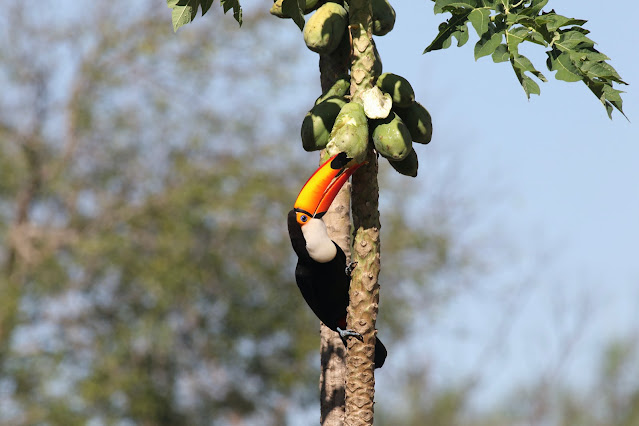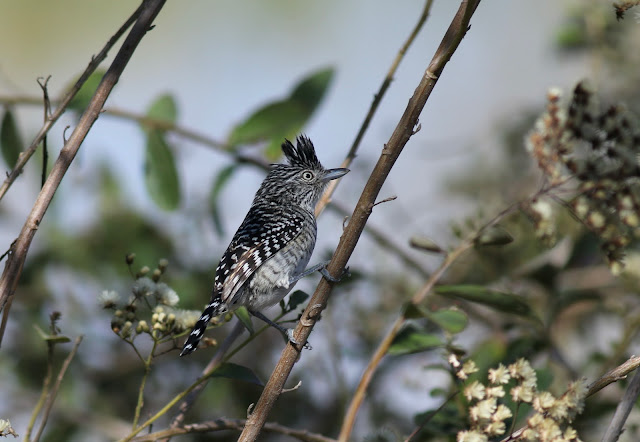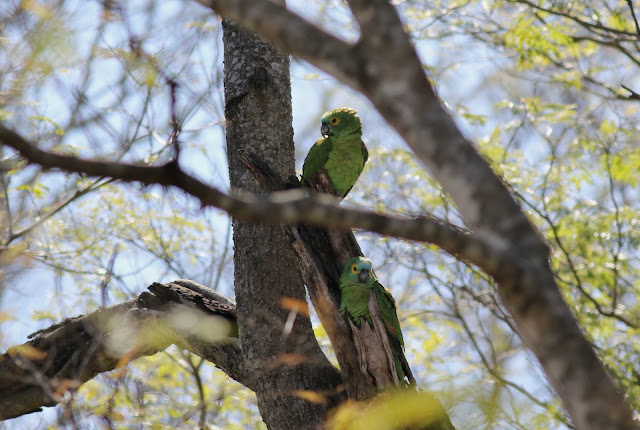Grayish Baywing
Chalk-browed Mockingbird
Great Kiskadees were super common but I think this might be the only pic I took of one.
Red-legged Seriemas were frequently too close to get in frame.
Gilded Hummingbird - The guide said he saw a Hermit of some kind at the Firecracker plant near the pool, but I could only find these Gilded.
Crested Caracaras were also super common but again I only ended up with a handful of pics.
As for the Hyacinth Macaws, I couldn't resist taking pics each time I saw them.
Campo Flickers - up to this point we had not seen any of these so I was excited and got some of the others to come look at them. It turned out they were fairly common.
I spent quite a bit of time trying to get a good photo of Crested Oropendolas but they were skittish.
 Toco eating some papayas.
Toco eating some papayas.Bare-faced Curassow
Nine-banded Armadillo - I believe you count the light bands, not the dividing darker ones.
Red-legged Seriema strutting its stuff.
Scaley-headed Parrot - this is one of only two terrible shots I got of this southeast South American species.
Nanday Parakeets on the other hand were very accommodating.
Lineated Woodpecker - at first glance this photo looks like it needs to be rotated, but this bird was actually clawing upside-down.
As you can probably tell the Lineated is closely related to our Pileated.
White-tipped Dove - same species we get in the Lower Rio Grand Valley. We also had Gray-fronted Dove which is very similar but has a more contrasting head to body coloration.
After my solo walkabout during siesta we headed down to the river to take a boat ride. I neglected to take a picture of the boat but it was a basic long and skinny river panga with comfy seats built in for the express purpose of wildlife viewing.
This Golden-mantled Howler Monkey female was waiting for us down at the boat landing. The females are golden all over while the males are mostly dark.
Crane Hawks are kind of funny looking with their small head to body ratio.
Chestnut-capped Foliage-gleaner - shooting this bird from the boat was a challenge but a few of the many pics came out decent.
Blue-throated Piping-guan - these large birds were quite common in the very tallest trees lining the river but they were really good at keeping sticks between their face and my camera.
Crane Hawk fly-by.
No sticks this time!
Pantanal Caiman
Green Kingfisher
Black-backed Water-tyrant - we had these in Colombia but it was nice to get reacquainted.
Black-collared Hawk
The boat ride was pleasant but I noticed the bilge (water at our feet) was full of gasoline. Luckily I noticed this right away and kept my bag off the floor of the boat but despite my warnings some of the others did not and they eventually had to junk the bags or put up with the smell the rest of the trip.
Back on terra firma we noticed some new species of Parrot and Macaws starting to roost in the palm trees outside the Pousada.
Orange-winged Parrot - sadly the best photo I could get in the fading light.
Red-shouldered Macaws - another of the smaller macaw species that we only saw on this one occasion.
After the sun set, it was time for dinner but the wildlife didn't stop for that.
This Crab-eating Fox visited us at dinner presumably waiting for some table scraps.
Here is the Wiki description:
The crab-eating fox (Cerdocyon thous), also known as the forest fox, wood fox, bushdog (not to be confused with the bush dog) or maikong, is an extant species of medium-sized canid endemic to the central part of South America since at least the Pleistocene epoch.[1][2][4]Like South American foxes, which are in the genus Lycalopex, it is not closely related to true foxes. Cerdocyon comes from the Greek words kerdo (meaning fox) and kyon (dog) referring to the dog- and fox-like characteristics of this animal.
Great times and we have 1 more full day of Pousada Aguape to get through. Next installment, Brazil Day 4. Maybe I can get the whole day done in one post now that we got the common species out of the way.


















































































